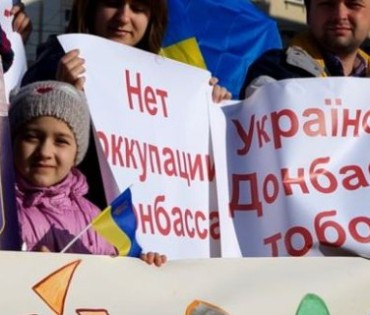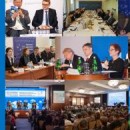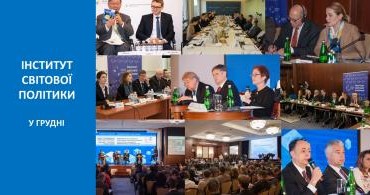Director of the IWP Alyona Getmanchuk about the situation in the occupied part of Donbass and possible analogies with TransnistriaThe fact that events in Donbas are developing according to the “Transnistria scenario” has been obvious since the beginning of the conflict. Some analogies were impressive, including the fake elections that are not recognized by the whole civilized world.
Still, on one hand, there are some things that make the situation in Donbas worse than one in Transnistria, and on the other, there are things that are still playing in our favor.
Let’s start with the criteria that make the “DNR” worse than the “PMR”.
1. Unlike Transnistria, Donbas has common border with the Russian Federation. While Transnistria could be suppressed by purely economic means and any new military equipment and troops shipments have always been problematic, constant Russian military support of Donbas is already a done deal. Paradoxically, due to the common border Ukraine has much more influence on situation in Transnistria than on its own territories in Donetsk and Luhansk oblasts.
2. Value of Moldova to Russia cannot be compared with the value of Ukraine. The weight of Moldova in the concepts of “the Russian world” and the Eurasian Union is significantly less than the weight of Ukraine. The “Slavic brotherhood” myth also does not work in Moldova’s case. While it has been admitted by the Russian officials during the closed-door summits that Transnistria poses no value to the Russian Federation and the only reason why the conflict is still underway is that the Western governments haven’t yet proposed the right price for its resolution, the situation in Donbas is much more complex. Donbas could also become invaluable to Putin at some point; still, the price for it would be many times higher than the price for Transnistria.
3. Russia does not tend to maintain the conflict in Donbas in frozen state. In Transnistria, Russia has already seen that the frozen conflicts could obstruct the European of Euro-Atlantic integration of its neighboring states, but are not able to block the pro-European policy ultimately. Despite the frozen conflicts in Moldova and Georgia, both states have signed the Association Agreements. Therefore, in order to block any integration into the EU or the NATO, the conflict should be maintained in at least brewing state.
Besides, frozen conflicts tend to be removed from the list of the state’s and society’s priorities sooner or later. In Moldova, the Transnistrian conflict has reached the point when it allowed Chisinau to adjust the priorities: first European integration of the country, and then its reintegration. In other words, first the EU and then Transnistria. Indications are that such scenario is unlikely for Ukraine: the European integration would occur (or would not occur) simultaneously with reintegration. In Ukraine’s case, Putin expects the conflict in Donbas to be the top-priority issue for the state and society by draining their resources and energy constantly.
4. Russia positions the conflict in Donbas as an outright war against the United States. Subsequently, the Russian disinformation machine explains its actions in Ukraine as an appropriate reaction on the US’s policies; such an explanation has proper feedback not only inside the Russian Federation, but also in numerous European countries. In case of Transnistria, however, the most abominable external force was Romania. While possible war with Romania could not mobilize much forces in Transnistria, the war against the USA in Donbass, if required, could drive immense global support, even if the US do not actually wage war in Ukraine.
5. After all, Moldova has achieved at least limited success on its way towards European integration, which could be “sold” to Transnistria, by having established the visa-free regime with the EU on April 28, 2014. After that, the number of Transnistria’s residents willing to obtain the passport of the citizen of Moldova has increased three times, compared to the same period last year. Ukraine, however, has no success stories with the EU, and thus, Donbas residents could question the practical effects of the European integration. From their point of view, the pro-European policy affects them in negative way, by bringing European prices instead of European salaries.
Why is the situation in the Donbas still better?
1. The Ukrainian authorities did not enter direct negotiations with the separatists. Conventionally speaking, the President Petro Poroshenko did not negotiate with Zakharchenko or Plotnitskyi, the so-called leaders of the “DPR” and the “LPR”, respectively, despite the Russia’s shameless pressure. Basically, replacement of Russian citizen Girkin with Ukrainian citizen Zakharchenko and subsequent faked elections were both aimed at making the “authorities” chosen by the Russian Federation look like the government elected by the people. For instance, Zakharchenko claimed yesterday that he is ready to meet Poroshenko, obviously in order to downgrade the conflict from the interstate to interregional level, to the conflict between Kyiv and Donetsk/Luhansk.
2. Donbas has much higher demands than the Transnistria. While Russia tends to overspend, they cannot afford to fully maintain Donbass after doing the same for Crimea. There are almost 4 million residents in Donbas, compared to 400,000 in the Transnistria, which is around 10 times more. Since Transnistria costs out at about 1 billion dollars per year, one could easily estimate the potential costs of similar regime in Donbas for the Russian budget. Moreover, the region’s infrastructure would not have been eliminated that zealously if the Russian Federation had really planned to bankroll Donbas.
3. Moldova’s army cannot be compared even to Ukraine’s one (21st place in the global rating of military forces as of August 2014). And they are unlikely to acquire a better one, as they do not strive for that. Any military-related conflict resolution method did not seem possible for Moldova a priori. Therefore, Chisinau was destined to seek only for diplomatic solutions to the conflict. Ukraine, however, has a chance for at least suspended military solution. The “Croatian scenario” is actually the light at the end of the tunnel, which at least adds some optimism to rather sad story.
4. Ukraine is receiving international support on completely different level compared to that of Moldova at the time when the state called “the PMR” has been established de-facto. At that moment border of the European Union has been so far from Moldova that everything that has happened was perceived lightly and thus irresponsibly. Nowadays, the EU border runs along the borders of Ukraine and Moldova. Obviously, the idea of the Eastern Partnership had worked poorly, as the accent has been made on the economy, while it should have been made on security, taking into account the neighboring Russian Federation.
5. Ukraine does not and should not adopt any peacekeeping mission from the Russian Federation. Russia has discredited the very idea of a peacekeeping mission by proving in the Transnistria that its missions are aimed primarily at preserving and developing the institutions of local separatist formations and not at establishing and sustaining peace. Their success is measured by how long they remain on the country’s territory and not by their response and solution term which is a common requirement for the UN missions. The extent of the Russian Federation’s sensitivity to those issues could be illustrated by the Russian Foreign Ministry’s statement concerning the executive summary on reforming the peacekeeping mission in Transnistria presented recently by the Institute of World Policy in Brussels.
6. The massive attack of the Russian television in Moldova. The most popular TV channel in Moldova is the “Channel One” of (former RPT, Russian Public Television). It covers the entire country and concentrates the lion’s share of local TV advertising. Since the rights to rebroadcast this channel (and thus, the broadcasting income) are in possession of one of the richest people in Moldova – Vlad Plakhotniuk – it is unlikely that he would agree to lose those profits for the sake of the country’s information security.
7. The territories of Donbas seized by the militants could be reintegrated faster than Transnistria. During the last 22 years Transnistria has raised a generation that regards the PMR as its homeland and has been consistently persuaded by the local media that Moldova is the enemy. Some PMR’s youth could easily spend their time in the Chisinau’s “MallDova” shopping center, only to continue viewing themselves as a separate nation. Furthermore, the language gap between Kyiv, Lviv and Donetsk is more subtle compared to that between the banks of Dniester. It is much easier to understand Ukrainian than Romanian for the Russian speaker, and according to various polls, 75 to 80% of Moldova’s residents speak Romanian, while Moldovan youth mostly does not speak Russian.
Therefore, it is not so bad, but time is definitely playing against us.




Comments theme
Comments themeComments themeComments themeComments themeComments themeComments themeComments themeComments themeComments themeComments themeComments themeComments themeComments themeComments themeComments themeComments themeComments themeComments themeComments themeComments.